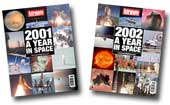


|

|
|
Largest mirror in space under development EUROPEAN SPACE AGENCY Posted: February 18, 2004 The European Space Agency's Herschel Space Observatory, designed to make observations in the infrared and sub-milimetre band, is due to be launched in February 2007. Engineers have recently completed a crucial phase of the project by manufacturing its 3.5-metre main mirror from silicon carbide. Use of this revolutionary material will result in a primary with a mass one fifth of a conventional mirror. Further machining is required before it can be given its reflective coating.
The silicon carbide segment manufacture and blank fabrication was performed by Boostec (Tarbes, France). The prime contractor for the Herschel telescope is EADS Astrium SAS (Toulouse, France). All the major telescope components - the primary and secondary mirrors and the hexapod that supports the secondary mirror - are made from silicon carbide, allowing the telescope mass to be reduced to 300 kg rather than the 1.5 tonnes that would have resulted from using conventional materials. In addition to substantial mass savings, silicon carbide also offers the excellent structural stability and thermal properties needed to maintain a mirror location accuracy of better than 10 µm. The mirror blank will now be machined by Boostec to remove the internal stiffeners, used to provide mechanical stability during manufacture, and reduce the shell thickness to 2.5 mm. After machining, the mirror will be polished by Opteon (Turku, Finland) to obtain a parabolic surface with a roughness of less than 30 nm. The mirror accuracy will be such that the completed telescope will have a total wavefront error of less than 6 µm RMS. The polished mirror will be coated by vacuum deposition at the Calar Alto Observatory (Almerķa, Spain), first with a 10 nm thick adhesive layer of nickel-chrome and then with a 300 nm reflective layer of aluminium. |
|
2004 Yearbook NEW!
Order your copy of the Astronomy
Now 2004 Yearbook. The hottest astronomy news stories from recent years,
a round-up of the best new products and a complete night-sky observing guide
for 2004. NEW!
Order your copy of the Astronomy
Now 2004 Yearbook. The hottest astronomy news stories from recent years,
a round-up of the best new products and a complete night-sky observing guide
for 2004.Exploring the Solar System  The Solar System is our cosmic backyard in the sprawling metropolis of
the Milky Way galaxy. Within this guide to exploring the Solar System,
you'll find pictures presented in lavish full colour and accompanied with
clear lay-language descriptions.
The Solar System is our cosmic backyard in the sprawling metropolis of
the Milky Way galaxy. Within this guide to exploring the Solar System,
you'll find pictures presented in lavish full colour and accompanied with
clear lay-language descriptions. Two years of space history  Buy the 2001 and 2002 editions of A Year In Space and save off the regular price. Starry Night  The highly acclaimed Starry Night range of software is now available from
the Astronomy Now Store. Put the universe on your desktop.
The highly acclaimed Starry Night range of software is now available from
the Astronomy Now Store. Put the universe on your desktop. |
||||||